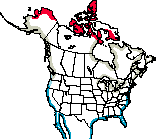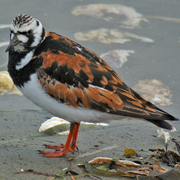Ruddy Turnstone
General Description
The Ruddy Turnstone is a compact shorebird with distinctive plumages and bright orange legs. It has a short, wedge-shaped bill that it uses in its unique foraging style. The male in breeding plumage has a rufous back, striped with black and white. The belly is white, and the head is boldly patterned in black and white. A bold, black 'U' in front of the wing is a prominent feature on the male in breeding plumage, and is visible, although less so, in all other plumages. In flight, the Ruddy Turnstone shows white at the base of the tail, on the wings, and on the back. Females and males in non-breeding plumage are duller than breeding males, their backs mottled gray-brown rather than rufous.
Habitat
Ruddy Turnstones breed in the Arctic tundra. During migration and winter, they inhabit coastal areas with sandy or rocky shores, although they are most typically found on mudflats, especially those with rocks. In migration, they can be found inland in plowed fields.
Behavior
Ruddy Turnstones flock in small groups, larger in spring than fall, and often occur with Dunlins and Red Knots in the spring. Active foragers, turnstones are best known for their habit of turning over objects and eating the food underneath. They are quite strong and have been known to turn over rocks as big as their own heads. They also flip over seaweed, small sticks, and other objects in their search for food. When moving from place to place locally, Ruddy Turnstone flocks fly in tight groups. During migration, they fly in loose lines.
Diet
Ruddy Turnstones are generalists. They eat anything they can find under rocks and seaweed, as well as carrion and often the eggs of small, colonial terns.
Nesting
Nests are located on the open ground in wet tundra areas or dry rocky ridges. They are sometimes well concealed among rocks or under shrubs. The female builds the nest, a shallow depression with a sparse lining of leaves. Both parents incubate the four eggs for 22 to 24 days. The young leave the nest shortly after hatching and follow the male to food. They feed themselves, but both parents help protect and tend the young. The female usually departs first, leaving the male to watch over the young until they can fly, typically at 19 to 21 days.
Migration Status
The Ruddy Turnstone is a bird of both the Old and New Worlds. Ruddy Turnstones travel from their Arctic nesting grounds to coastal wintering grounds from the southern United States to South America. Range-wide, they winter along the coastlines of every continent except Antarctica.
Conservation Status
The Canadian Wildlife Service estimates the worldwide population of Ruddy Turnstones to number 449,000, with 235,000 breeding in North America and the rest throughout the Arctic. They are common and widespread. Their remote breeding range and widespread winter range should help them remain a common species.
When and Where to Find in Washington
While a few Ruddy Turnstones sometimes winter at Coupeville on Whidbey Island (Island County) and in Willapa Bay (Pacific County), they are predominantly migrants in Washington. They are most common in spring, from late April through May, when they are common on the outer coast and uncommon on the protected shores of Puget Sound and the Strait of Juan de Fuca. Migrants are less common in fall than in spring, but they are still fairly common. Adults come through from mid-July to early August, and juveniles follow from late August to late September.
 Abundance
Abundance
| Ecoregion | Jan | Feb | Mar | Apr | May | Jun | Jul | Aug | Sep | Oct | Nov | Dec |
|---|---|---|---|---|---|---|---|---|---|---|---|---|
| Oceanic | ||||||||||||
| Pacific Northwest Coast | R | R | U | U | F | U | U | U | R | R | R | |
| Puget Trough | R | R | R | U | U | U | U | R | R | R | R | |
| North Cascades | ||||||||||||
| West Cascades | ||||||||||||
| East Cascades | ||||||||||||
| Okanogan | ||||||||||||
| Canadian Rockies | ||||||||||||
| Blue Mountains | ||||||||||||
| Columbia Plateau |
Washington Range Map

North American Range Map


Family Members
 Spotted SandpiperActitis macularius
Spotted SandpiperActitis macularius Solitary SandpiperTringa solitaria
Solitary SandpiperTringa solitaria Gray-tailed TattlerTringa brevipes
Gray-tailed TattlerTringa brevipes Wandering TattlerTringa incana
Wandering TattlerTringa incana Greater YellowlegsTringa melanoleuca
Greater YellowlegsTringa melanoleuca WilletTringa semipalmata
WilletTringa semipalmata Lesser YellowlegsTringa flavipes
Lesser YellowlegsTringa flavipes Upland SandpiperBartramia longicauda
Upland SandpiperBartramia longicauda Little CurlewNumenius minutus
Little CurlewNumenius minutus WhimbrelNumenius phaeopus
WhimbrelNumenius phaeopus Bristle-thighed CurlewNumenius tahitiensis
Bristle-thighed CurlewNumenius tahitiensis Long-billed CurlewNumenius americanus
Long-billed CurlewNumenius americanus Hudsonian GodwitLimosa haemastica
Hudsonian GodwitLimosa haemastica Bar-tailed GodwitLimosa lapponica
Bar-tailed GodwitLimosa lapponica Marbled GodwitLimosa fedoa
Marbled GodwitLimosa fedoa Ruddy TurnstoneArenaria interpres
Ruddy TurnstoneArenaria interpres Black TurnstoneArenaria melanocephala
Black TurnstoneArenaria melanocephala SurfbirdAphriza virgata
SurfbirdAphriza virgata Great KnotCalidris tenuirostris
Great KnotCalidris tenuirostris Red KnotCalidris canutus
Red KnotCalidris canutus SanderlingCalidris alba
SanderlingCalidris alba Semipalmated SandpiperCalidris pusilla
Semipalmated SandpiperCalidris pusilla Western SandpiperCalidris mauri
Western SandpiperCalidris mauri Red-necked StintCalidris ruficollis
Red-necked StintCalidris ruficollis Little StintCalidris minuta
Little StintCalidris minuta Temminck's StintCalidris temminckii
Temminck's StintCalidris temminckii Least SandpiperCalidris minutilla
Least SandpiperCalidris minutilla White-rumped SandpiperCalidris fuscicollis
White-rumped SandpiperCalidris fuscicollis Baird's SandpiperCalidris bairdii
Baird's SandpiperCalidris bairdii Pectoral SandpiperCalidris melanotos
Pectoral SandpiperCalidris melanotos Sharp-tailed SandpiperCalidris acuminata
Sharp-tailed SandpiperCalidris acuminata Rock SandpiperCalidris ptilocnemis
Rock SandpiperCalidris ptilocnemis DunlinCalidris alpina
DunlinCalidris alpina Curlew SandpiperCalidris ferruginea
Curlew SandpiperCalidris ferruginea Stilt SandpiperCalidris himantopus
Stilt SandpiperCalidris himantopus Buff-breasted SandpiperTryngites subruficollis
Buff-breasted SandpiperTryngites subruficollis RuffPhilomachus pugnax
RuffPhilomachus pugnax Short-billed DowitcherLimnodromus griseus
Short-billed DowitcherLimnodromus griseus Long-billed DowitcherLimnodromus scolopaceus
Long-billed DowitcherLimnodromus scolopaceus Jack SnipeLymnocryptes minimus
Jack SnipeLymnocryptes minimus Wilson's SnipeGallinago delicata
Wilson's SnipeGallinago delicata Wilson's PhalaropePhalaropus tricolor
Wilson's PhalaropePhalaropus tricolor Red-necked PhalaropePhalaropus lobatus
Red-necked PhalaropePhalaropus lobatus Red PhalaropePhalaropus fulicarius
Red PhalaropePhalaropus fulicarius

